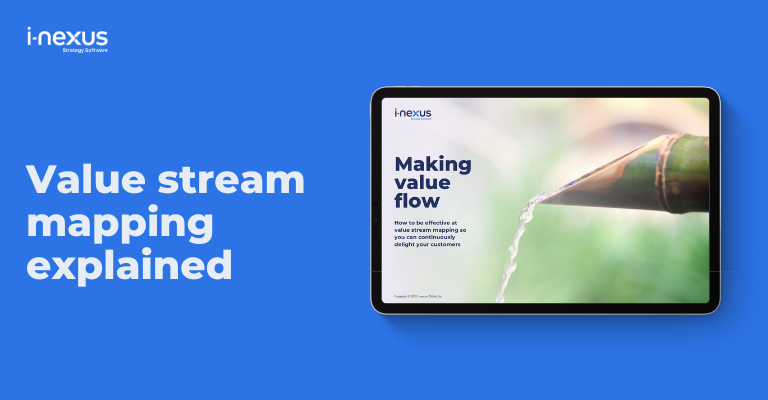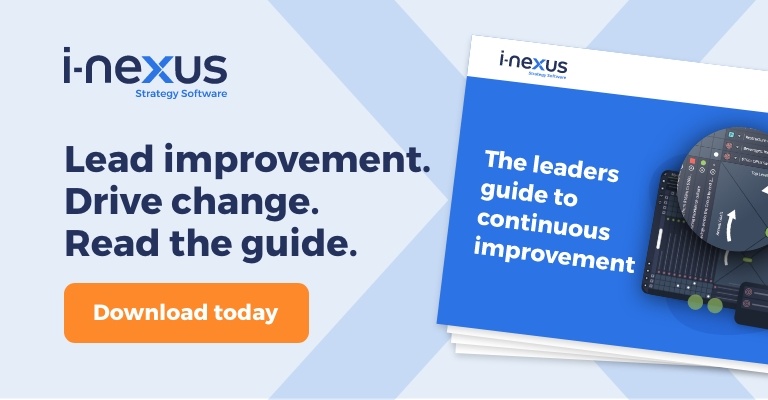Learn what a value stream map is, why it's important, the benefits, icons, challenges, why you should create one, plus more in this mapping overview.
Written by: Nigel Richardson and James Milsom
What is a value stream?
You have to look back to Womack, Jones, and Roos' seminal 'The Machine That Changed The World' book for the roots, and indeed a definition of a value stream:
"The critical starting point for lean thinking is value. Value can only be defined by the ultimate customer.”
Value, and the value stream, is the evolution of Muda (waste). It encourages organizations to look beyond targeting waste in their processes at face value. Waste, or value, should be evaluated in the eyes of the customer.
This idea of a value stream is not limited to the traditional customer, buying your goods. In fact, it stretches from that traditional customer right to the raw materials and production efforts to create goods/services.
Value can come from multiple sources, such as:
- A prospect visiting your website or store
- Responding to demo or quote requests
- Creating value propositions
- Manufacturing goods/services
- Billing your customer
- Delivering goods/services to the customer
- After-sale surveys and customer support
Therefore, value comes from a multi-stage journey (stream) with different actors involved. Value can be found in:
- Reducing internal wastes, i.e. the time of transit, mistakes, etc.
- Increase external value, i.e. additional features or services of value to your customer.
Download our free guide to future and current state value stream maps and much more by clicking below:
What are the different types of value stream?
There are several types of value stream:
- Goods/services requests and delivered to an external customer
- Value-enabling support streams, e.g. recruitment or onboarding
- Complex work, e.g. New Product Development
Do value streams go in two directions?
In short, yes.
An example value stream may be one where a customer selects a lawyer, then spends time with their lawyer drafting their will, the will is altered and finally, the will is delivered to the Executor.
Alternatively, your value stream may go from online viewing of products to in-store order, to item delivery, and then customer collection.
It pays, therefore, to consider the scope of your value stream.
What is a value stream map?
If the value stream is a series of processes and activities that your organization goes through to deliver value to your customer, the value stream map itself is an all-encompassing view of how work flows through your systems.
It offers a visual management option to understand every task and gives a status update on how each element of the stream is progressing.
The American Society for Quality offers this value stream mapping definition:
"VSM is an essential lean tool for an organization wanting to plan, implement, and improve while on its lean journey. VSM helps users create a solid implementation plan that will maximize their available resources and help ensure that materials and time are used efficiently."
Why value stream mapping is important
A value stream map is important because it is much more than a work flow design tool. It provides a gateway to encourage transformational, bigger picture thinking, placing the customer at the heart of it all, and allowing your operational excellence to support strategic efforts.
The benefits of value stream mapping include:
- Offering visual stimuli to identify how the entire work flow creates value, where disconnects exist, and the role everyone plays in this process
- Connecting all work to the customer - helping with the change management challenge of shifting internally focused staff to the external, customer concerned thinking approach
- Simplifying the complex - the sheer amount of work that goes into a value stream can be hard to explain, but this map gives a simple explanation to which you can speak
- Encouraging organizational thinking - the value stream map allows you to zoom out from a particular process, realizing that, for example, if your website is optimized for digital purchases, but the order process behind it isn't capable of supporting this demand, the value stream breaks down.
How is a value stream map different from a process map?
If a value stream map is holistic, then a process map is more specific, focusing in on one element of the value stream.
The process map will likely be owned by one process engineer, whereas the value stream map will involve a Head of Excellence or someone with senior leadership. After all, it is an opportunity to look at the bigger picture value, as opposed to focusing on one stage.
With the process map, micro, tactical improvements are made, whereas the value stream mapping exercise allows for a more strategic view of the work flow.
Furthermore, the process map is internally focused, covering one function. The value stream map is formed through collaboration, crossing functions in the name of what delivers customer value.
Process maps, as well, will often involve great detail, and therefore take a longer time to formulate visually, whereas the value stream map will involve multiple parties building out the view of the work flow, therefore taking less time to create.
Value stream mapping icons
Value stream management involves the mapping out of your work flow, and inevitably the use of icons.
These value stream mapping icons include some of the below:
 |
Scheduling and production control through an inventory control system like Material Requirements Planning. |
 |
The truck shows when an item is being shipped to a customer or supplier. |
 |
This shows the direction of materials from suppliers or goods going from factory to customers. |
 |
The inventory between processes is shown by these icons, with the count below. |
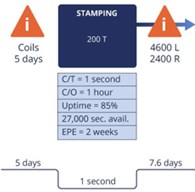 |
The timeline at the bottom of the map shows waiting times and processing times, and can be used to create a Lead Time and Total Cycle Time. |
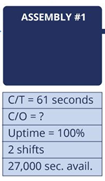 |
The icon 'ASSEMBLY #1' covers the process, machine or department tasked with this part of the production. |
 |
The data box shows the data needed when analyzing the system. |
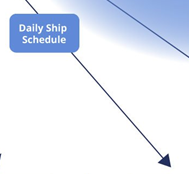 |
Manual information flow through a memo, report, schedule, conversation etc. |
 |
Digital information flow through the internet, fax, email. |
An example value stream map
Let’s continue with a picture below as an example value stream map viewed from two perspectives - the information and material flows.
The information flow is where the production control center requests orders, for example via the Michigan Steel Co. website, and pushes this order and the necessary material required into the production arm of the organization.
The production flow is where the information of the orders are manufactured and then delivered to the customer, covering the order of material, their transit, manufacturing, and then delivery.
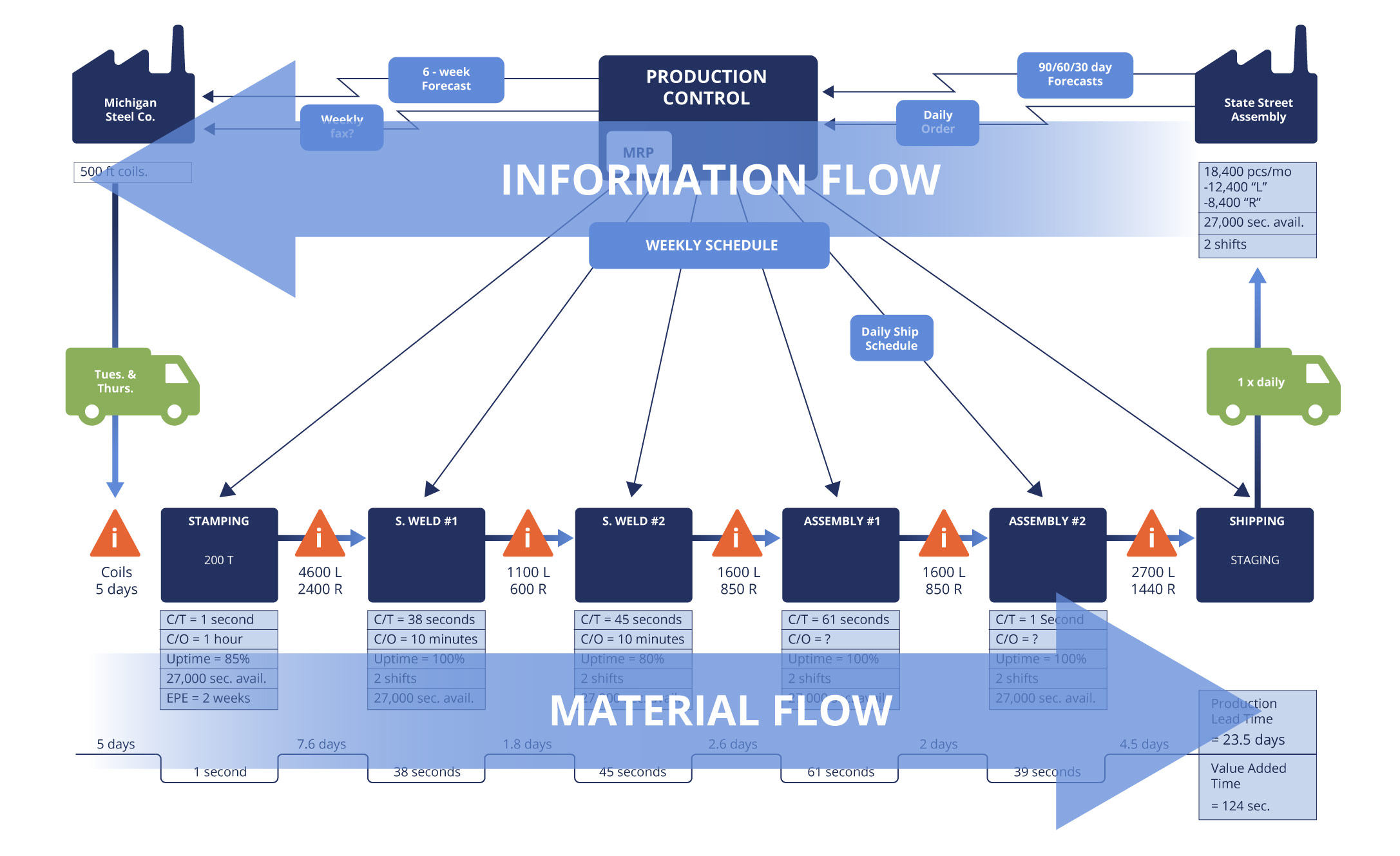 To explain the value stream map above:
To explain the value stream map above:
- The order is placed on michigansteel.com
- The order forecast is sent to the materials factory, 500ft coils are required
- On Tuesday and Thursday these materials are transported, typically taking five days
- From here the item goes through the manufacturing phase - stamping, welding, assembling and then delivery - the diagram shows the items required, the time involved, uptime and more.
- Here you can generate a lead time and value added time to indicate how long it takes to manufacture the item, and value added time, showing the time spent to improve that process.
- The goods are then shipped over to the State Street Assembly, taking one day
- These are then fed back into the production control, and shipped to the customer
This can be created on multiple A3 sheets of paper.
Should you use an A3 value stream map?
In all honesty, I have never used them. But, I believe it comes down to preference.
Most workshops are completed using post-its so the option for sophisticated iconography is limited, although a consistent use of post-it color to the type of content is recommended.
What you should aim for is the simplicity of information, such as these information boxes:
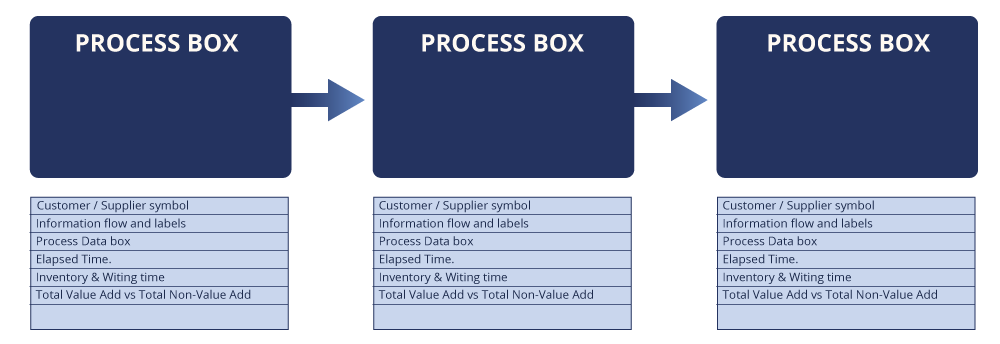
Why bother with value stream mapping?
To those who have never seen a Value Stream Map (VSM) before, it can be a daunting thing to get your head around.
But, VSM gives clarity on where value is being added in a process, enabling you to then drive greater efficiency with delivering your product/service.
And, for that reason alone, if you want to lead improvement in your organization, it's a crucial piece of the puzzle.
Value streams are certainly very different from other process mapping techniques and the initial reaction can often be “does it need to be this complicated?”. In fact, one look at value stream diagrams may very well support that.
There may well need to be a loop of education and persuasion to get you to a point where you have a level of buy-in for this approach, regardless of whether you are an expert at Value Stream Mapping.
Today we are looking at six reasons which should make the Value Stream Mapping process the method of choice in your Lean management:
1) It is a cross-functional perspective
It is a tool that joins people together from various parts of the organization who in reality have never had the opportunity or motivation to do so before.
2) Value Stream Maps capture information flow
In addition to the logical flow of your process or service, it also captures information flow.
Very few methods allow the integration of information flow in your business processes in such an effective way.
3) Your operating model is presented to you on a page
Very few mapping techniques build out the additional considerations of monitoring and control of your end-to-end performance above and beyond the delivery.
4) They become the canvas for your improvement conversations
Once stakeholders understand what they are looking at, it becomes incredibly easy to communicate large amounts of information that improvements of this nature require to enable clear, informed decision-making to allow improvement definition and prioritization
5) It visualizes the importance of ‘upstream performance’
Stakeholders earlier in the process become very aware of how their own performance is critical in how the remainder of the end-to-end process actually performs.
From a stakeholder management perspective, this is vital as in many cases these stakeholders believe the problems relate to functions further down the end-to-end process.
6) The improvement is in the gaps
There can be a lot of focus on how to improve a task, make it faster, more efficient.
Value Stream Maps highlight the gaps between those processes where either a customer is waiting or product is being built up as inventory.
It is these gaps that create the most waste or the poor customer experience, so investing in how the tasks are completed to eliminate or reduce this time in the gaps is a subtle but critical difference in focus.
So, is value stream mapping beneficial for your organization?
With a value mapped out, your team will be in a place to understand the end-to-end stream of your operations, track performance, and then be in a stronger place to make those processes more efficient.
That is, in essence, the purpose of a Lean Value Stream Map.
Undoubtedly, these 6 reasons highlight the value of mapping, with waste and bottlenecks identified, increased process efficiency, better product quality and cross-functional collaboration among the benefits of adopting this Lean technique.
Continue learning about continuous improvement
Click here to learn more about continuous improvement, or take a look at these content recommendations:
- Value Stream Mapping Explained: Go beyond the textbook and download this 30+ page guide based on real-life practitioner experience.
- DMAIC v Six Sigma v Lean: Our guide to the steps and tools you'll need when driving process improvement through one of these three methodologies.
- The Leader's Guide to Continuous Improvement: Download this eBook to get a comprehensive overview of how DMAIC, Six Sigma, Lean, PDCA can support your business in finding a competitive advantage.
About the author
Nigel Richardson is a continuous improvement expert. His background spans 20 years in business transformation and continuous improvement across retail, pharma, aviation, and the IT supply chain. He is passionate about supporting organizations to achieve their strategic, transformational, and improvement goals, and outperform their peers year after year.
If you’d like to talk more about your strategic challenges, reach out to him on nigel.richardson@i-nexus.com or connect with Nigel on LinkedIn for the latest Strategy Execution insights.
